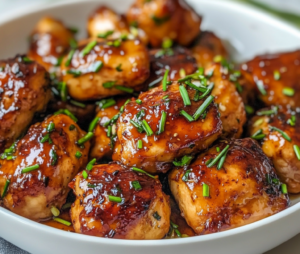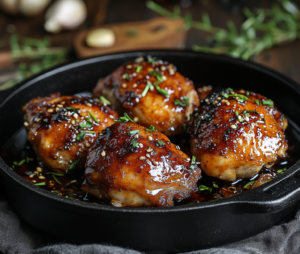Introduction to Sticky Chicken
Sticky chicken has a special place in the world of comfort foods, beloved for its perfect blend of sweet, savory, and sometimes spicy flavors that adhere wonderfully to well-cooked poultry. This dish isn’t just a meal; it’s a symphony of tastes that come together beautifully.
Historically, the method of making chicken “sticky” through glazes or sauces likely emerged from various culinary traditions. Each culture adds its unique twist with local ingredients like honey, soy sauce, or even fruit-based glazes. Today, this dish enjoys popularity across the globe, featured in both bustling restaurants and quiet, home kitchens.
The widespread appeal of this dish comes from its versatility and the ease with which chefs can inject personal flair. Whether it’s a casual family meal or a more formal gathering, it can take center stage. Additionally, it serves as a great vehicle for experimenting with different flavor combinations and cooking techniques, which we will explore more in the upcoming sections.
Recipes and Variations
Classic Sticky Chicken Recipe
To begin with, let’s dive into the quintessential recipe that many adore—a classic sticky chicken that masterfully combines simplicity with flavor. This dish is often the first introduction for many into the world of glazed poultry, offering an irresistible balance of sweet and savory.
- Ingredients:
- Chicken thighs or breasts
- Honey or maple syrup for a touch of sweetness
- Soy sauce for that umami depth
- Garlic and ginger, finely minced
- A hint of chili flakes for a little kick (optional)
- Method:
- Firstly, combine the honey, soy sauce, garlic, ginger, and chili flakes in a bowl to create your marinade.
- Secondly, coat the chicken thoroughly with the marinade and let it marinate, ideally for a few hours in the fridge.
- Thirdly, preheat your oven to 375°F (190°C). Place the chicken on a baking tray lined with parchment paper and bake until the chicken is caramelized and cooked through, typically about 35-40 minutes.
- Furthermore, baste the chicken occasionally with the marinade during cooking to enhance its stickiness and flavor.
This dish is not only a crowd-pleaser but also serves as a perfect introduction to cooking with glazes.
Variations of Sticky Chicken
Moreover, adventurous cooks might want to explore variations that incorporate different ingredients and techniques, each adding a unique twist to the traditional recipe.
- Honey Mustard Sticky Chicken:
- Combine honey with mustard and a bit of apple cider vinegar to create a tangy version that still satisfies that sticky-sweet craving.
- Sweet and Spicy Sticky Chicken:
- Add a generous amount of hot sauce or sriracha to the marinade for those who favor a fiery flavor profile.
- Sticky Lemon Pepper Chicken:
- Introduce lemon zest and cracked black pepper into your marinade for a citrusy, zesty take that’s refreshing and bold.
Each of these variations adheres to the basic principles of sticky chicken but introduces elements that can transform the dish into a whole new experience. Additionally, experimenting with different components not only broadens your culinary repertoire but also keeps your dining table exciting. Whether you stick to the classic recipe or venture into new variations, each version promises a delightful meal that’s sure to captivate your taste buds.
Nutritional Information
Understanding the nutritional aspects of sticky chicken is crucial, especially for those mindful of their diet. This dish, delicious as it is, contains components that impact its nutritional profile both positively and negatively.
Caloric Content: Typically, sticky chicken is moderately high in calories, mainly due to sugars and fats in the marinades and sauces. However, the choice of ingredients can greatly alter the caloric impact.
Protein Source: Chicken, the main component, is an excellent source of lean protein, essential for muscle repair and growth. The type of chicken used (breasts vs. thighs) affects the fat content; thighs are slightly higher in fat but richer in flavor.
Carbohydrates: The glazes often include honey or syrup, adding carbohydrates mainly from sugars. These ingredients are key for the stickiness but can spike blood sugar levels.
Micronutrients: Common ingredients like garlic and ginger offer health benefits such as improved immune function and anti-inflammatory properties. Adding sesame seeds or scallions can boost the dish’s vitamins and minerals.
Dietary Adjustments:
- For those reducing sugar, using natural sweeteners like stevia or less honey can help lower the sugar content without losing flavor.
- Using low-sodium soy sauce is an easy way to cut sodium levels, benefiting those with blood pressure issues.
By understanding these nutritional elements, individuals can make informed decisions about including sticky chicken in their meals. Adjusting the recipe to fit dietary needs can make it a healthier option that still satisfies cravings for a sweet and savory dish.
“Chicken and Dumplings with Biscuits – A Comfort Food Guide”
Cooking Tips and Techniques
Perfecting sticky chicken involves more than just following a recipe—it’s about mastering the art of timing and flavor balance. Here are some essential tips and techniques that can elevate your cooking to the next level.
Achieving the Perfect Glaze
- Consistency is Key: The glaze should be thick enough to cling to the chicken but not so heavy that it drips off. Simmering your sauce on low heat can help achieve the right consistency.
- Application Timing: Apply the glaze only in the last 10-15 minutes of cooking. This prevents the sugars in the sauce from burning and ensures a perfectly caramelized finish.
Cooking Methods
- Baking: For a healthier version, baking is ideal. It allows the chicken to cook evenly and the glaze to caramelize without burning.
- Grilling: Grilling adds a smoky flavor that complements the sweetness of the glaze. Just be sure to keep the heat medium to avoid burning the sugars.
- Slow Cooking: For deeper infusion of flavors, slow cooking is effective. It tenderizes the chicken and allows it to absorb the sauce thoroughly.
Common Mistakes to Avoid
- Over-marinating: While marinating is crucial for flavor, too long can make the chicken mushy. Ideally, three to four hours is sufficient.
- High Heat: Cooking at too high a temperature can cause the glaze to burn. Moderate heat ensures that the chicken cooks through and the sauce achieves the perfect sticky texture.
- Neglecting to Baste: Basting not only adds more flavor but also helps to keep the chicken moist. Make sure to baste every 10-15 minutes during cooking.
Additionally, using a meat thermometer can help ensure that your chicken reaches the safe internal temperature of 165°F (75°C) without overcooking. Implementing these tips and techniques will not only make your sticky chicken dishes more delicious but also more consistent in quality, ensuring that each bite is as satisfying as the last.
USDA’s Safe Chicken Handling Practices
Serving and Presentation Ideas for Sticky Chicken
When it comes to serving sticky chicken, presentation can significantly enhance the dining experience, making the dish not only delicious but also visually appealing. Here are some creative ideas for plating and accompanying your sticky chicken to impress your guests and satisfy your palate.
Creative Plating Techniques for Sticky Chicken
- Garnishing with Style: Sprinkle finely chopped green onions, sesame seeds, or fresh herbs over your sticky chicken right before serving. These not only add a pop of color but also introduce fresh flavors that complement the dish.
- Dramatic Plating: Serve the chicken on a flat, white plate with a drizzle of reduced sauce from the pan around the chicken. This technique creates an aesthetically pleasing contrast that highlights the glaze’s shine and color.
Recommended Side Dishes for Sticky Chicken
- Rice Varieties: Sticky chicken pairs wonderfully with steamed jasmine rice, which can soak up the delicious glaze, or a bed of fluffy fried rice for added texture and flavor.
- Vegetable Accompaniments: Bright, steamed vegetables like broccoli, snow peas, or bell peppers not only add a crunch but also make the meal more balanced and colorful.
- Salads: A light, crisp salad with a tangy dressing can cut through the richness of the dish, offering a refreshing side that cleanses the palate.
These serving and presentation ideas are designed to enhance the enjoyment of your sticky chicken. Whether it’s a casual family dinner or a special occasion, these tips will help make your meal a memorable one. The right presentation turns a simple dish into a feast for the eyes, making every bite a pleasure.
The Cultural Significance of Sticky Chicken
Sticky chicken resonates across global culinary traditions, embodying unique adaptations and flavors. This section delves into its historical context and cultural significance.
Historical Context of Sticky Chicken
- Origins: The technique of cooking meat with a sweet and savory glaze has ancient roots across various cultures. It’s difficult to pinpoint the exact origin of sticky chicken, but similar styles appear in Asian cuisines, notably Chinese, where honey and soy-based sauces have been staples for centuries.
- Evolution: Over time, sticky chicken has evolved by embracing local ingredients and tastes. This adaptability has made it a favorite in households and restaurants around the world.
Sticky Chicken in Cultural Celebrations
- Festive Meals: In many traditions, dishes like sticky chicken are central to celebrations and family gatherings. Its rich flavors and communal serving style suit festive occasions perfectly.
- Symbolic Meanings: Often, the ingredients in sticky chicken carry symbolic meanings. For instance, sweetness can represent happiness and prosperity, making the dish a popular choice for celebrations like New Year’s and weddings.
This rich cultural heritage makes sticky chicken more than just a meal; it’s a celebration of heritage and communal joy. Whether it’s served in a casual home setting or as part of a grand feast, sticky chicken brings people together, transcending cultural boundaries with its universally appealing flavors.
FAQs
Answering frequently asked questions about this popular dish can provide insights and resolve common curiosities. Here, we address some of the most common inquiries related to preparing and serving this flavorful chicken.
What makes the chicken coating sticky?
- Ingredients and Cooking: The characteristic stickiness comes from components like honey, syrup, or sugar in the marinade or sauce. As these sugars are exposed to heat, they caramelize, forming a sticky, glossy exterior on the poultry.
How can I make this dish healthier?
- Ingredient Swaps: To improve the healthiness of the meal, consider using natural sweeteners such as honey instead of refined sugar, opt for low-sodium soy sauce, and incorporate more spices for enhanced flavor without extra salt. Choosing to bake or grill rather than frying can also significantly reduce calorie intake.
What are the best sides to accompany this dish?
- Complementary Sides: Perfect accompaniments include fluffy steamed rice or a vibrant fried rice variant, which are excellent for absorbing the rich sauce. Adding light, crunchy vegetables like broccoli or a crisp, fresh salad can effectively balance the meal’s richness.
Can this dish be prepared in advance?
- Preparation Tips: Indeed, marinating the poultry in advance and storing it in the refrigerator overnight can be a great time-saver and flavor enhancer. For optimal texture and taste, it’s best to cook it fresh when you plan to serve.
These FAQs aim to enhance your culinary experience, ensuring each preparation is as delightful as possible. Whether you are just starting in the kitchen or have extensive cooking experience, these tips can help perfect your dish and satisfy your culinary aspirations.




